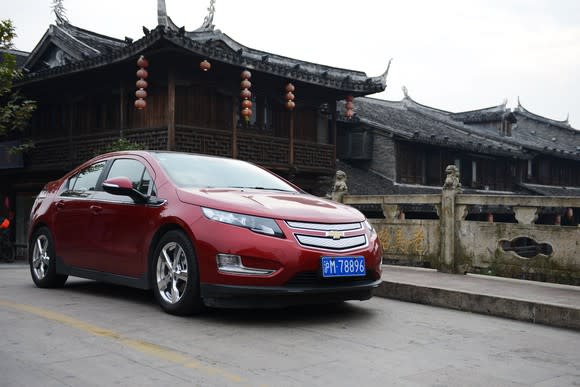1 Area Where General Motors Is Absolutely Dominating Its Crosstown Rival
Rivalries -- whether a great sport rivalry, such as the Lakers and Celtics, or a business rivalry, such as Coca Cola and Pepsi -- make the world an exciting place. Detroit is home to a historic competition, too: Ford Motor Company (NYSE: F) and General Motors (NYSE: GM) are neck and neck in so many ways, their decades-long rivalry is awesome to watch. But Detroit's largest automaker, General Motors, has been crushing Ford in an increasingly important market: China. And the results so far in 2018 are ugly.
By the numbers
Let me preface these sales figures by noting that General Motors entered China long before Ford -- admittedly a mistake on Ford's part -- and the gap between the two in the world's largest automotive market is only getting larger. General Motors posted a 7.8% sales gain in China during February. That sales gain seems even better when you consider that February had fewer selling days due to the Chinese Lunar New Year holiday occurring last month versus January in 2017. The unequal comparison was a primary reason China's overall light-vehicle deliveries declined 9.6% in February from the prior year.

Image source: General Motors.
If you wonder what a bad month looks like -- considering GM's 7.8% gain was a good result -- look no further than Ford's continued sales slump. Ford's China deliveries plunged 30% in February from a year ago, and failed to notch even 50,000 units. Even if you combine Ford's first two months in China, to help balance out the Lunar New Year holiday shift between 2017 and 2018, the automaker's sales still plunged 23%. In other words, General Motors sold more vehicles in China during February alone than Ford has year to date -- more than twice as many.
When speaking to Reuters about Ford's relationship with its joint ventures, Peter Fleet, head of Ford's Asia-Pacific operations, had this to say: "I think our partnerships are in good shape, and I want them to be even better." But he cautioned, "This year will be a bit like going through a tunnel," adding, "We have to get through 2018."

Data source: Ford sales press releases. Chart by author.
Light at the end of the tunnel
Now more than ever, automakers need China to become not only a growth story but a stronger generator of profits; despite the fact that China's new-vehicle market is already larger than the domestic one, the U.S. remains far more profitable. But as China's middle class grows and demands SUVs, which are more profitable for automakers, Ford knows it's time to double down on its plans to expand in China. To that end, it has announced its China 2025 Plan.
Ford's plan in China calls for more than 50 all-new vehicles to be introduced by the end of 2025. Of those, eight will be all-new SUVs and 15 all-new electric vehicles (EV), as Ford prepares to capitalize on China's pollution problem and the government's incentives for EV sales. As the lucrative U.S. new-vehicle market plateaus, Ford needs 2019 to get here in a hurry in hopes that a fresher vehicle lineup can help reignite growth in a region where GM dominates Detroit and Japanese automakers. Ford also needs its Lincoln luxury brand to gain traction in China to help create a more profitable growth story -- thus far the Chinese view the Lincoln brand more highly than we do in the States.
For now, despite an intense rivalry between General Motors and Ford in almost every aspect, GM is killing Ford in China. If that doesn't change, it will be a serious hurdle for Ford's bull thesis.
More From The Motley Fool
Daniel Miller owns shares of Ford and General Motors. The Motley Fool owns shares of and recommends Ford. The Motley Fool has a disclosure policy.

